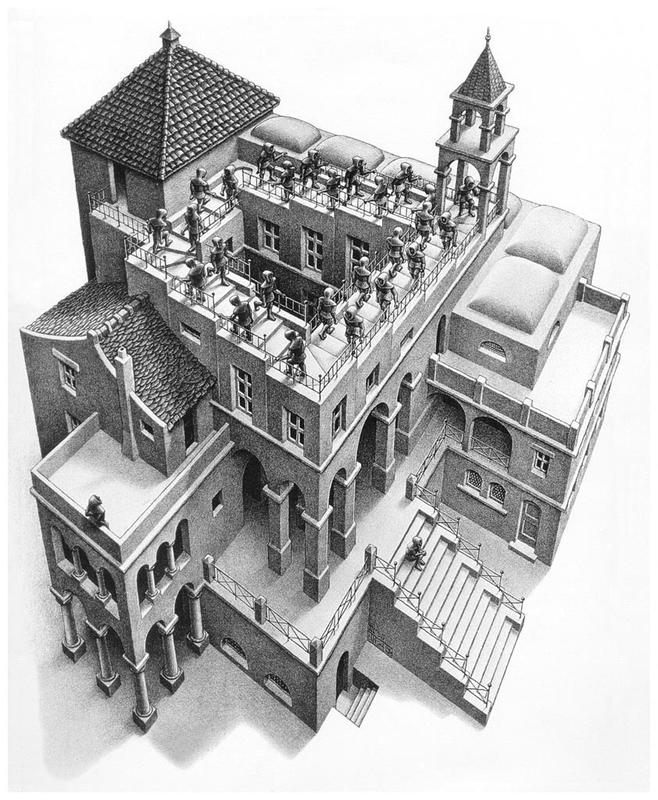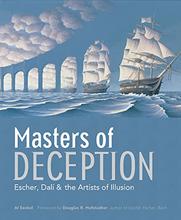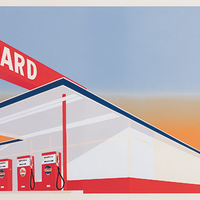More about Ascending and Descending
- All
- Info
- Shop

Contributor
If the feeling of déjà vu has saturated your brain to the point of psychosis, you may be stuck in a M.C. Escher original.
Now think how he must have felt all the time…actually, it is probably better that you don’t do that. Few of us have the ability to really understand the mathematical, analytical, and innovative mind of this artistic genius, but I think all of us have the aptitude to see that he was one far-out dude.
Feast your eyes upon the never-ending staircase! Twelve monks are going down while fourteen go up. Always ascending, always descending, never escaping. It would seem to be an impossibility, but we need to remember that nothing is inconceivable in the world of M.C. Escher. Is your brain hurting yet?
I have failed almost every math class I have taken throughout my education. How then, you may be wondering, did I graduate from high school? Well, it turns out that arguing incessantly with authority figures can get you a long way in life. Needless to say, I thought my decision to become an artist in college would propel me through my collegiate days free of the woes of the mathematical world. I was wrong. Turns out, math is totally essential to art. From Escher to our Renaissance homies like Leonardo da Vinci, who showed us that proportion and depth are completely dictated by the laws of mathematics. *Pause for me to go weep in the corner*
Escher loved math. He once said, “For me it remains an open question whether [this work] pertains to the realm of mathematics or to that of art.” As much as Escher and math get grouped together, Escher is actually doing a dishonor to his beloved subject, and this lithograph is a perfect example. It appears that the stairs are both ascending and descending, a mathematical impossibility in 3D! But it can totally exist in the realm of two dimensions. Not to give all the credit to Escher though, the idea of these never-ending stairs was thought of a year prior to this piece by mathematician and psychiatrist Lionel Penrose.
So here they are, stuck walking around forever. It may seem like a curse to some, but many monks practice walking meditation. Perhaps these meandering souls are on a path towards spiritual bliss and enlightenment. Me on the other hand, I think I may have just found my worst-feared purgatory…
Featured Content
Here is what Wikipedia says about Ascending and Descending
Ascending and Descending is a lithograph print by the Dutch artist M. C. Escher first printed in March 1960. The original print measures
14 in × 11+1⁄4 in (35.6 cm × 28.6 cm). The lithograph depicts a large building roofed by a never-ending staircase. Two lines of identically dressed men appear on the staircase, one line ascending while the other descends. Two figures sit apart from the people on the endless staircase: one in a secluded courtyard, the other on a lower set of stairs. While most two-dimensional artists use relative proportions to create an illusion of depth, Escher here and elsewhere uses conflicting proportions to create the visual paradox.
Ascending and Descending was influenced by, and is an artistic implementation of, the Penrose stairs, an impossible object; Lionel Penrose had first published his concept in the February 1958 issue of the British Journal of Psychology. Escher developed the theme further in his print Waterfall, which appeared in 1961.
The two concentric processions on the stairs use enough people to emphasise the lack of vertical rise and fall. In addition, the shortness of the tunics worn by the people makes it clear that some are stepping up and some are stepping down.
The structure is embedded in human activity. By showing an unaccountable ritual of what Escher calls an 'unknown' sect, Escher has added an air of mystery to the people who ascend and descend the stairs. Therefore, the stairs themselves tend to become incorporated into that mysterious appearance.
There are 'free' people and Escher said of these: 'recalcitrant individuals refuse, for the time being, to take part in the exercise of treading the stairs. They have no use for it at all, but no doubt, sooner or later they will be brought to see the error of their non-conformity.'
Escher suggests that not only the labours, but the very lives of these monk-like people are carried out in an inescapable, coercive and bizarre environment. Another possible source for the look of the people is the Dutch idiom monnikenwerk ("a monk's job"), which refers to a long and repetitive working activity with absolutely no practical purposes or results, and, by extension, to something completely useless.
Two earlier Escher pictures that feature stairs are House of Stairs and Relativity.
Check out the full Wikipedia article about Ascending and Descending


















